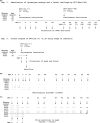An attenuated strain of enterovirus 71 belonging to genotype a showed a broad spectrum of antigenicity with attenuated neurovirulence in cynomolgus monkeys
- PMID: 17567701
- PMCID: PMC1951441
- DOI: 10.1128/JVI.02856-06
An attenuated strain of enterovirus 71 belonging to genotype a showed a broad spectrum of antigenicity with attenuated neurovirulence in cynomolgus monkeys
Abstract
Enterovirus 71 (EV71) is a causative agent of hand, foot, and mouth disease and is also sometimes associated with serious neurological disorders. In this study, we characterized the antigenicity and tissue specificity of an attenuated strain of EV71 [EV71(S1-3')], which belongs to genotype A, in a monkey infection model. Three cynomolgus monkeys were inoculated with EV71(S1-3'), followed by lethal challenge with the parental virulent strain EV71(BrCr-TR) via an intravenous route on day 45 postinoculation of EV71(S1-3'). Monkeys inoculated with EV71(S1-3') showed a mild neurological symptom (tremor) but survived lethal challenge by virulent EV71(BrCr-TR) without exacerbation of the symptom. The immunized monkey sera showed a broad spectrum of neutralizing activity against different genotypes of EV71, including genotypes A, B1, B4, C2, and C4. For the strains examined, the sera showed the highest neutralization activity against the homotype (genotype A) and the lowest neutralization activity against genotype C2. The order of decreasing neutralization activity of sera was as follows: A > B1 > C4 > B4 > C2. To examine the tissue specificity of EV71(S1-3'), two monkeys were intravenously inoculated with EV71(S1-3'), followed by examination of virus distribution in the central nervous system (CNS) and extraneural tissues. In the CNS, EV71(S1-3') was isolated only from the spinal cord. These results indicate that EV71(S1-3') acts as an effective antigen, although this attenuated strain was still neurotropic when inoculated via the intravenous route.
Figures



Similar articles
-
Establishment of an animal challenge model as a potency assay for an inactivated Enterovirus Type 71 vaccine.Biologicals. 2016 Jul;44(4):183-190. doi: 10.1016/j.biologicals.2016.01.003. Epub 2016 Apr 8. Biologicals. 2016. PMID: 27068365
-
A comparative study of multiple clinical enterovirus 71 isolates and evaluation of cross protection of inactivated vaccine strain FY-23 K-B in vitro.Virol J. 2017 Oct 26;14(1):206. doi: 10.1186/s12985-017-0872-8. Virol J. 2017. PMID: 29073897 Free PMC article.
-
Identification and characterization of a cross-neutralization epitope of Enterovirus 71.Vaccine. 2011 Jun 10;29(26):4362-72. doi: 10.1016/j.vaccine.2011.04.010. Epub 2011 Apr 16. Vaccine. 2011. PMID: 21501643
-
Prospect and challenges for the development of multivalent vaccines against hand, foot and mouth diseases.Vaccine. 2014 Oct 29;32(47):6177-82. doi: 10.1016/j.vaccine.2014.08.064. Epub 2014 Sep 13. Vaccine. 2014. PMID: 25218294 Review.
-
EV71: an emerging infectious disease vaccine target in the Far East?Vaccine. 2010 Apr 30;28(20):3516-21. doi: 10.1016/j.vaccine.2010.03.003. Epub 2010 Mar 19. Vaccine. 2010. PMID: 20304038 Review.
Cited by
-
Therapeutic and prevention strategies against human enterovirus 71 infection.World J Virol. 2015 May 12;4(2):78-95. doi: 10.5501/wjv.v4.i2.78. World J Virol. 2015. PMID: 25964873 Free PMC article. Review.
-
Necrotizing myositis causes restrictive hypoventilation in a mouse model for human enterovirus 71 infection.Virol J. 2013 Jun 28;10:215. doi: 10.1186/1743-422X-10-215. Virol J. 2013. PMID: 23809248 Free PMC article.
-
Immunization of N terminus of enterovirus 71 VP4 elicits cross-protective antibody responses.BMC Microbiol. 2013 Dec 10;13:287. doi: 10.1186/1471-2180-13-287. BMC Microbiol. 2013. PMID: 24320792 Free PMC article.
-
Enteroviruses in the early 21st century: new manifestations and challenges.Curr Opin Pediatr. 2016 Feb;28(1):107-13. doi: 10.1097/MOP.0000000000000303. Curr Opin Pediatr. 2016. PMID: 26709690 Free PMC article. Review.
-
RSAD2 and AIM2 Modulate Coxsackievirus A16 and Enterovirus A71 Replication in Neuronal Cells in Different Ways That May Be Associated with Their 5' Nontranslated Regions.J Virol. 2018 Feb 26;92(6):e01914-17. doi: 10.1128/JVI.01914-17. Print 2018 Mar 15. J Virol. 2018. PMID: 29263272 Free PMC article.
References
-
- Abubakar, S., H. Y. Chee, N. Shafee, K. B. Chua, and S. K. Lam. 1999. Molecular detection of enteroviruses from an outbreak of hand, foot and mouth disease in Malaysia in 1997. Scand. J. Infect. Dis. 31:331-335. - PubMed
-
- Arita, M., N. Nagata, T. Sata, T. Miyamura, and H. Shimizu. 2006. Quantitative analysis of poliomyelitis-like paralysis in mice induced by a poliovirus replicon. J. Gen. Virol. 87:3317-3327. - PubMed
-
- Arita, M., H. Shimizu, and T. Miyamura. 2004. Characterization of in vitro and in vivo phenotypes of poliovirus type 1 mutants with reduced viral protein synthesis activity. J. Gen. Virol. 85:1933-1944. - PubMed
-
- Arita, M., H. Shimizu, N. Nagata, Y. Ami, Y. Suzaki, T. Sata, T. Iwasaki, and T. Miyamura. 2005. Temperature-sensitive mutants of enterovirus 71 show attenuation in cynomolgus monkeys. J. Gen. Virol. 86:1391-1401. - PubMed
Publication types
MeSH terms
Substances
LinkOut - more resources
Full Text Sources
Other Literature Sources
Miscellaneous

